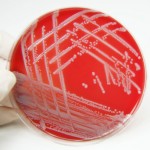


A staph infection is a group of infections caused by staphylococcus, which can result in anything from a minor skin infection to a serious infection that can affect the lungs, heart and blood. Although many staph infections can be treated, there are some that are antibiotic resistant, which are more harmful.
Antibiotic resistant staph infections are known as methicillin-resistant Staphylococcus aureus (MRSA). PVL-Staphylococcus aureus, too, is resistant to many common antibiotics, which can also kill off disease-fighting white blood cells and lead to reoccurring skin infections.
There are two types of staph infection: skin and soft tissue infections and invasive infections. Skin and soft tissue infections include:
Invasive infections include:

One in three people carry the bacteria that can lead to staph infections harmlessly on their skin. Bacteria of this kind like to stay below the nose or the surface of the armpits and buttocks. The bacteria becomes problematic when it enters the body, either through a wound, insect bite or medical equipment, to name a few examples.
Staph infections can also be transmitted person to person in close proximity or by sharing contaminated objects like towels or toothbrushes. Contaminated food, too, can spread the bacteria, along with sneeze and cough droplets.
Anyone can develop a staph infection, but those with weakened immune systems, those who use medical equipment that is inserted (like a catheter), and those who experienced trauma to the skin causing an open wound, have the highest risk.
Symptoms of staph infections are dependent on what kind of infection it is. For example, if the bacteria affect the skin a boil may appear. If a person experiences toxic shock syndrome, they may encounter diarrhea, nausea, a rash, confusion, muscle aches and abdominal pain.
Always see your doctor immediately if you encounter a red painful area on your skin, pus-filled blisters or a fever.

Mild staph infections may not require specific treatment and may go away on their own within a few days. In some other cases, antibiotic topical creams or pills may be prescribed or boils and blisters may be drained.
Invasive staph infections require hospital treatment as the body needs to be supported along with the treatment being administered.
When you are treating a staph infection ensure you are taking the necessary precautions to not spread the bacteria. Don’t share personal objects, regularly wash your hands, disinfect areas where you have been, cover your nose and mouth when coughing or sneezing and avoid close contact with others.
Staph infection prevention tips include:
 Regularly washing your hands
Regularly washing your handsFollowing these tips can help increase your odds of successfully preventing a staph infection.
Cellulitis risk from staph infection of skin increases with obesity, weak immune system
In many countries around the world, cellulitis is on the rise, and experts know that cellulitis risk from staph bacterial infection increases with obesity, as well as a weak immune system. Cellulitis is a common bacterial infection of the skin with the potential to have serious consequences. It impacts the surface of the skin and the soft tissues underneath. It can happen if bacteria enters a break in the skin and spreads. Continue reading…
MRSA staph infections could be effectively treated with antimicrobials
MRSA staph infections could be effectively treated with antimicrobials. Methicillin-resistant Staphylococcus aureus (MRSA) infection is caused by a staph bacteria that has become resistant to many antibiotics commonly used to treat staph infections. Continue reading…
Copyright © www.orthopaedics.win Bone Health All Rights Reserved